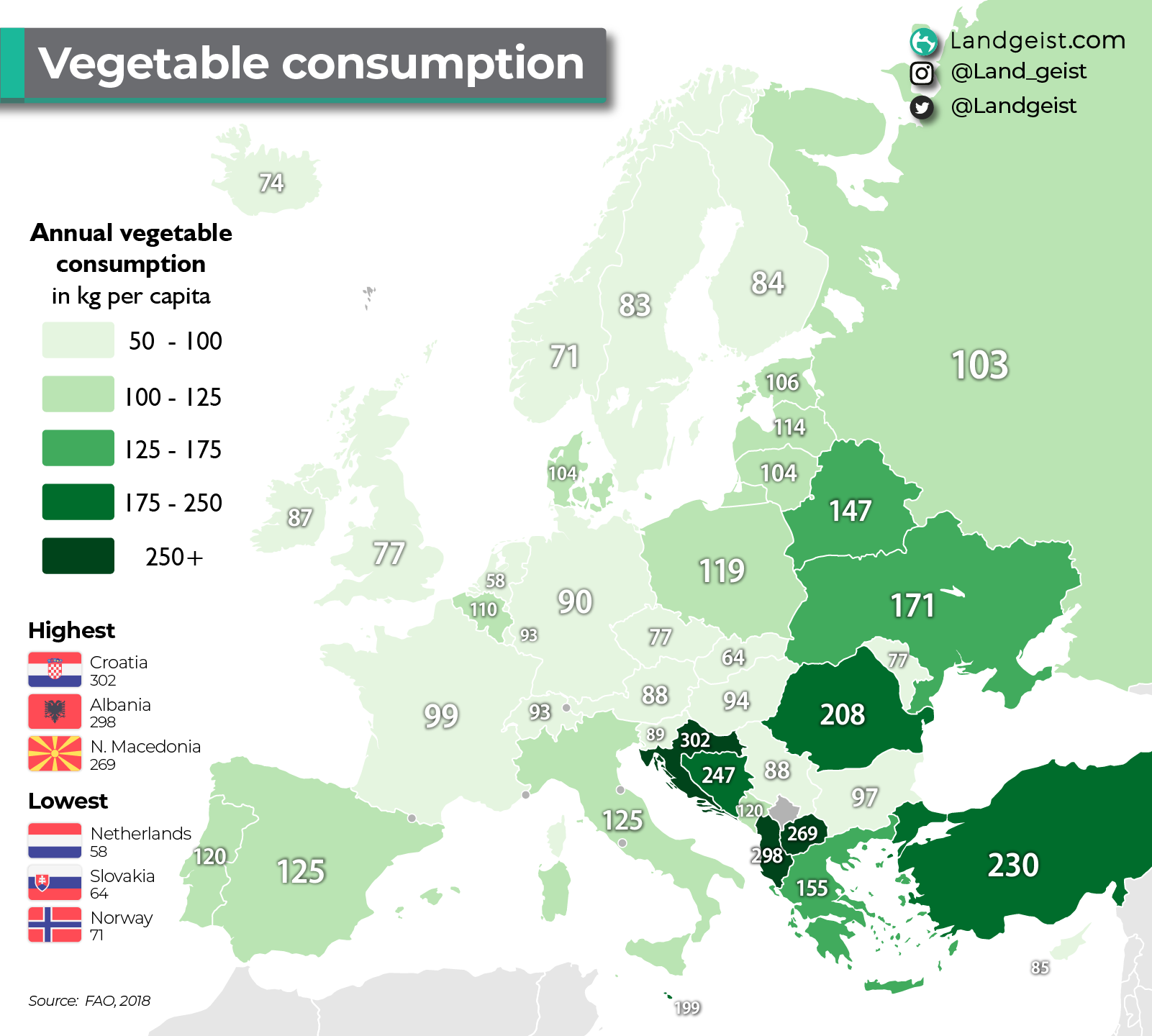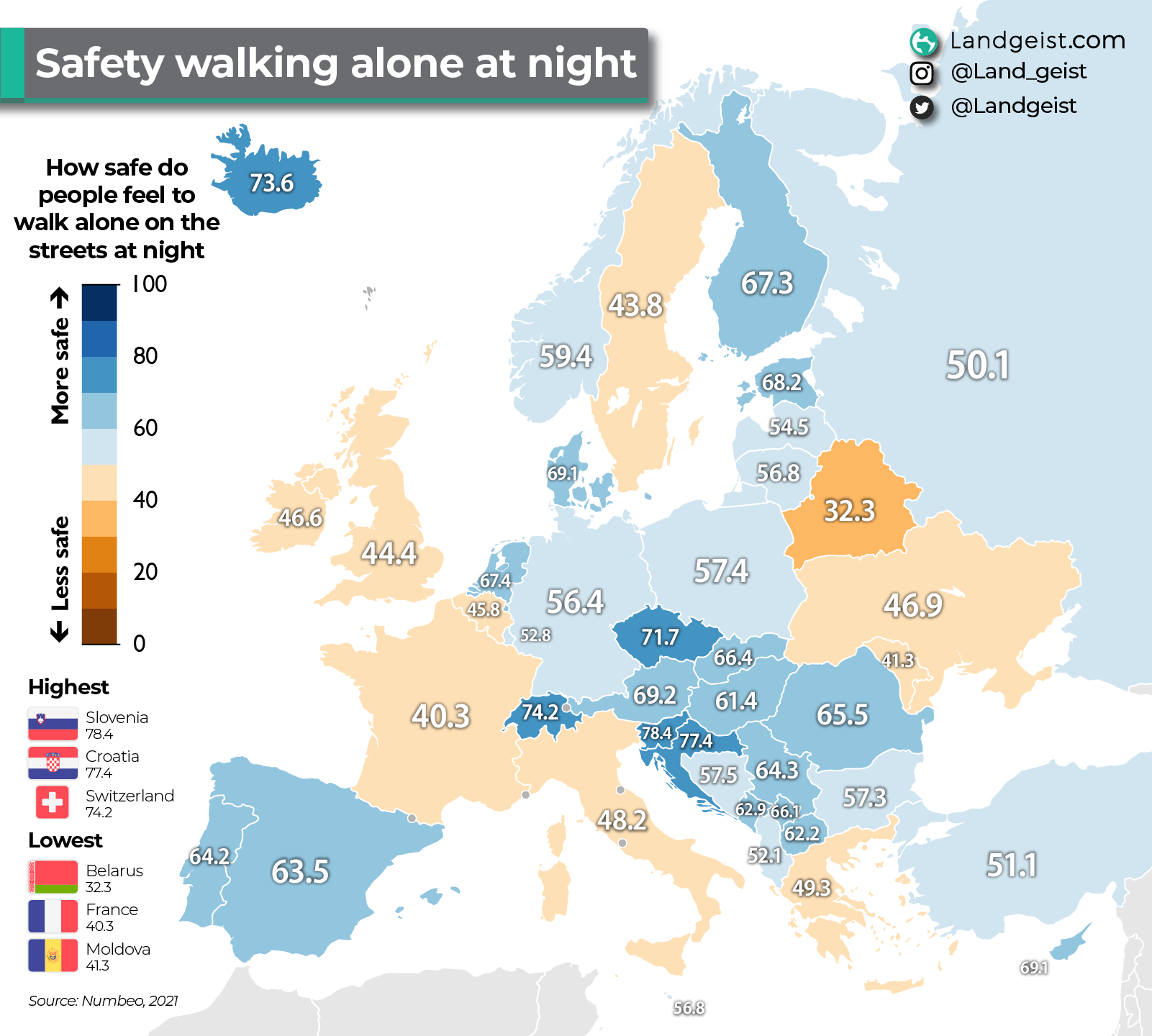Croatia Consumes More Vegetables Annually Than Any Other European Country
April 9, 2022 - According to statistics from the Food and Agriculture Organization of the United Nations (FAO), and compiled in a map made by Landgeist, Croatia consumes more vegetables per capita in a year than any other country in Europe.
Every day you learn something new about Croatia, and usually, they are things that you may never have imagined. When we talk about rankings, it is well known that Croatia is always among the first when it comes to the most beautiful countries in the world, the safest to walk at night, with the cleanest seas, among the best destinations for digital nomads, and much more.
However, would you have ever imagined that Croatia would be among the top when it comes to their consumption habits? According to statistics from the Food and Agriculture Organization of the United Nations (FAO), Croatia consumes more vegetables than any other European country. The Landgeist web portal compiled statistics from all European countries and created a map where it is possible to compare the annual consumption of kilos of vegetables per capita. According to these statistics, Croatia consumes 302 kgs of vegetables annually per capita.

Map: Landgeist.com
If you are Croatian, it may not surprise you that your country ranks among the top in vegetable consumption, especially if you look at your own plate during lunch both at home and in a restaurant. However, it is still a really remarkable fact that Croatia consumes more vegetables than any other European country considering that there is an agricultural tradition in the continent that goes back hundreds of years. If there is something worth highlighting, it is that Croatia's main competitors for this recognition are precisely countries of the Balkan region. In the second place ranks Albania with an annual consumption of 298 kilos of vegetables per capita, and in third place is North Macedonia, with an annual consumption of 269 kilos of vegetables per capita.
As Landgeist.com explains, the amount of vegetables one needs depends on age and sex. But on average, this is about 240 grams per adult per day or 87.6 kg per year.
''We can see that a bit more than half of the European countries meet this requirement. Cyprus, Czech Republic, Finland, Iceland, Moldova, the Netherlands, Norway, Slovakia, and Sweden do not meet the requirement, with the Netherlands consuming the smallest amount of vegetables in all of Europe'', states the web portal.
But how exactly does the FAO define vegetables? It probably matches mostly with what you would consider a vegetable. However, there are a few interesting exceptions. Potatoes are not counted as vegetables. Mushrooms, melons, and watermelons are. Yes, the FAO considers melons and watermelons vegetables. This is the FAO’s explanation: “This grouping differs from international trade classifications for vegetables in that it includes melons and watermelons, which are normally considered to be fruit crops. But, whereas fruit crops are virtually all permanent crops, melons and watermelons are similar to vegetables in that they are temporary crops”. If you want to see FAO's complete list on the classification of vegetables, click here.
In any case, congratulations to Croatia for continuing to stand out in lists that reflect healthy habits among its population!
For more, check out our lifestyle section.
Croatia, Second Safest European Country for Walking Alone at Night
November 29, 2021 - Based on statistics made by Numbeo, and compiled by the Landgeist web portal, Croatia is considered the second safest European country for walking alone at night, narrowly behind Slovenia, and ahead of Switzerland by more than three points.
There are things one must see or experience to confirm something that is said. About Croatia, I have already been able to corroborate almost immediately the turquoise color and transparency of its waters, as well as many of its customs and traditions. But being a person who by will has stopped going out constantly at night, it was difficult for me to take for granted the security that one has when walking at night in Croatian cities and towns. Even more to consider Croatia as the second safest European country to walk alone at night.
I remember when I was living in Rijeka and studying the Croatian language, my teacher asked the class to survey locals about life in their country. I did not know many people back then, as I had just arrived just a few months ago, in 2019. I had recently joined a film club at the Faculty of Philosophy and Humanities, and curiously I was the only male in the group. I asked three questions and emailed them to each one of the girls in my group. One of those questions was: ''What do you consider the most positive thing about living in Croatia?'' I may be wrong, but I remember almost with absolute certainty that all the answers to that question revolved around the safety of going outside and walking alone.
I know very well that historically, answering the question about safety on the streets can vary if the person surveyed is a woman or a man. I don't like talking assumptions, but living 24 years in Lima, Peru, I know that the reality of walking alone at night is uneven. My biggest fear was being mugged, but for a woman, it was being mugged, kidnapped, harassed, and more than it costs me to continue writing. I believe that the value of living in a place where you feel safe to walk alone at night greatly reflects the level of security in your country or city. Unfortunately, crime rates are measured differently and one thing is how safe you feel on the street and another is how safe your country really is.
Although the statistics to be presented in this article are prepared based on numerous factors and yield general results, it was enough for me to know the responses of my colleagues from the film club, as well as to see my 7-year-old neighbor returning home from school at 9:00 p.m., or walking with my cousins from the City Center One Mall in Split to the highway for us to wait for the bus almost at midnight, and many other experiences in these last two years, to confirm that walking alone at night through the streets of Croatia is safe indeed, and to be considered the second safest European country is not an exaggeration at all.
Regarding the Numbeo crime statistics published on November 15th of this year, and subsequently represented on a map and shared by Landgeist three days ago, the web portal commented the following:
''How safe one feels to walk alone on the streets at night, doesn’t necessarily say anything about the crime rate in the country. But it does give a very good sense of how safe people feel in their country. Although both are probably closely related, having a low crime rate doesn’t necessarily mean that people will also feel safe. Crime rates can give a skewed view in countries where crime is under-reported or people have lost faith in law enforcement and don’t report crimes anymore.
Apart from crime, there are other factors that can affect one's sense of safety, such as the presence of dangerous animals or poor urban planning that makes cities feel less safe than they are.
Of course, this statistic can vary from city to city and even between neighborhoods. Not just that, it can also vary depending on the demographic you ask. Data on these detailed statistics are non-existing for most countries. So keep in mind that this map only gives a very general view of how safe people feel to walk the streets alone at night per country.
Regardless of whether you think crime rates and how safe people feel are closely connected or not, let’s have a look at the map. Which will just give us an idea of how safe people feel to walk the streets alone at night.

Landgeist map, which shows Croatia as the second safest European country for walking alone at night with a score of 77.4.
We recently looked at how safe people in Asia feel to walk alone at night. As you can see, this map of Europe shows much smaller contrasts than the Asian map. No country in Europe scores over 80, but there are several countries in Asia that do score over 80. On the other hand, there is only one country in Europe that scores below 40. In Asia, there are quite a few countries that score below 40.
At the bottom end in Europe, there is one country that scores far lower than any other country: Belarus (32.3). The next 2 countries also score much lower than others: France (40.3) and Moldova (41.3). Sweden, the UK, Belgium, Ukraine, Ireland, Italy, and Greece also don’t score very well.
The highest scores can be found in Slovenia (78.4) and Croatia (77.4). The only ones to score over 75. Switzerland, Iceland, and the Czech Republic also score very well. The majority of the European countries seem to be scoring fairly OK, with most of them scoring between 50 and 70''.
For some, it may be one more curious fact. But Croatia is a country that from Zagreb, Slavonia, Istria, and even Dalmatia, can boast enviable numbers of tourism throughout the year. Nightlife is an important aspect of that reality, whether it is coming home from a rave, a nightclub, a bar, or a soccer game. Being the second safest European country for people to walk alone on the street at night cannot be overlooked, and it reinforces the idea that Croatia could be promoted as a safe destination for all, but it is a question of whether those who are to charge of showing the country to the rest of the world consider whether it is something important or not. We'll see.
For more on lifestyle, follow TCN's dedicated page.


